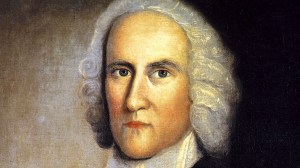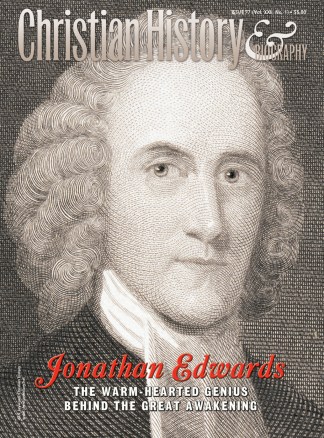In this series

Evangelical Co-founder
A man was born three months before Edwards and an ocean away who was to share the New England divine’s twin passions for the church and the life of the mind. That man was John Wesley, the founder of Methodism. The two never met, but they labored for their Lord on two continents, together helping to birth the movement called “evangelicalism.” Wesley read Edwards appreciatively and reprinted his Religious Affections, revising where the Puritan theologian’s Calvinism was most strongly expressed.
Revival Mediator
Edwards, a strong supporter of the Great Awakening, nevertheless took a cautious view of what went on in the revivals. On one hand, Edwards criticized the Awakening enthusiast James Davenport, who hotly insisted that many New England ministers were in fact unconverted and bound for hell, and who once burned a pile of classic Christian texts he considered insufficiently spiritual. On the other, Edwards debated the Boston rationalist clergyman Charles Chauncy, who argued true religion was a matter of the mind rather than the heart. “We should distinguish the good from the bad,” instructed Edwards, “and not judge of the whole by a part” (see p. 42).
Chocolate Addict
Consumed as a beverage usually at breakfast, “cakes” of chocolate were in steady demand in the Edwards household. The family often had to rely on travelers to Boston to procure it. In one letter, Edward begs the courier to save some of the chocolate he paid for. “If you will bring what remains,” he wrote, “you will much oblige your humble servant.”
Missionary to Mohicans
Most people don’t associate Jonathan Edwards with James Fenimore Cooper’s The Last of the Mohicans. But during Edwards’s stint in Stockbridge, Mohican children boarded at the mission school, and his son Jonathan spent a year in Mohican villages learning the language. Unfortunately, an arsonist burned the school down two years after Edwards’s arrival, and the French and Indian War broke out shortly after. The Mohicans abandoned Stockbridge, some to fight alongside the English and others to settle in Moravian towns (see p. 38).
Sabbath Progenitor?
Of Jonathan and Sarah Edwards’s eleven children, the first four were all born on Sundays. This caused the people of Northampton to enjoy some merriment at their pastor’s expense, as folklore had it that a child was born on the same weekday it was conceived.
Kindred Spirit
Edwards was not the only one to enjoy revival in 1735; a group of students and recent graduates at Yale College also experienced a movement of the Spirit. One of these was Aaron Burr, Sr., later husband of Edwards’s daughter Esther and father of the notorious Aaron Burr, Jr., second vice-president of the United States. In good Puritan fashion, Burr, Sr. first felt “polluted by nature and practice” and “almost concluded that my day of grace was past,” and then had an experience in which God revealed to him “in the Gospel, an all-sufficient and willing Saviour.” Burr eventually became Princeton College’s second president, and when he died in 1757, Edwards took his place.
Hedonist?
Rarely are the terms “Puritan” and “hedonist” put together, but Baptist pastor and author John Piper claims that Edwards was a hedonist. (That’s a compliment.) Throughout Desiring God: Meditations of a Christian Hedonist, Piper draws heavily on Edwards in arguing that “the pursuit of virtue must be, in some measure, a pursuit of happiness. … In all virtuous acts we pursue the enjoyment of the glory of God, and more specifically, the enjoyment of the presence and the promotion of God’s glory.”
As Edwards himself puts it in Charity and Its Fruits: “It is not contrary to Christianity that a man should love himself or, which is the same thing, should love his own happiness. That a man should love his own happiness, is as necessary to his nature as the faculty of the will is” (see p. 42 for more on Edwards, happiness, and self-love).
Inspirational Biographer
Among his many writings, Edwards may be most widely known for his sensitive editing of David Brainerd’s journal. The Life and Diary of David Brainerd, like A Faithful Narrative, has never gone out of print. The book records the heroic labors of this young missionary to the Indians, who died of tuberculosis at the age of 29, in the arms of his fiancee, Edwards’s daughter Jerusha. It galvanized the early American missions movement and inspired thousands worldwide—including the Baptist missionary leader William Carey—with its challenge to holiness and sacrifice.
Vaccination Victim
Edwards died from an inoculation to ward off smallpox, just after taking the presidency at Princeton. At the time, most physicians followed some variety of a practice called variolation when vaccinating patients. In one method, doctors took scabs from an infected person and blew them down the nostrils of a healthy one. Two to three percent of those variolated died. Forty years after Edwards’s death, English physician Edward Jenner vastly improved the vaccine when he discovered that people exposed to cowpox, a less serious disease, more effectively resisted smallpox.
Copyright © 2003 by the author or Christianity Today/Christian History magazine. Click here for reprint information on Christian History.











